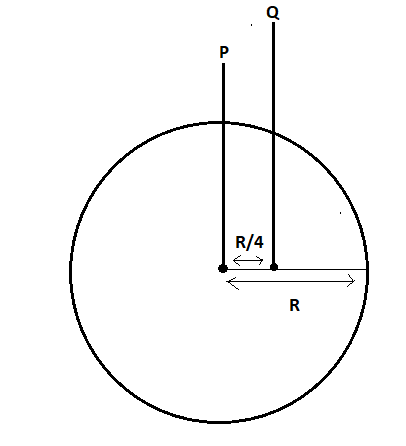
A small hole is made in a disc of mass M and radius R at a distance $\dfrac{R}{4}$ from the centre. The disc is supported on a horizontal peg through this hole. The moment of inertia of the disc about horizontal peg is
A. $\dfrac{{M{R^2}}}{9}$
B. $\dfrac{5}{{16}}M{R^2}$
C. $\dfrac{9}{{16}}M{R^2}$
D. $\dfrac{5}{4}M{R^2}$
Answer
569.1k+ views
Hint: Use parallel axis theorem to find the moment of inertia of the disc about horizontal peg.

Complete step by step answer:
We are given that a small hole is made in a disc of mass M and radius R at a distance $\dfrac{R}{4}$ from the centre. The disc is supported on a horizontal peg through this hole.
We have to calculate the moment of inertia of the disc around the horizontal peg at point Q.
Moment of inertia is a quantity expressing a body's tendency to resist angular acceleration, which is the sum of the products of the mass of each particle in the body with the square of its distance from the axis of rotation.
Parallel axis theorem states that the moment of inertia of a body about an axis parallel to the body passing through its center is equal to the sum of moment of inertia of body about the axis passing through the center and product of mass of the body times the square of distance between the two axes.
Points P and Q are parallel.
Moment of inertia at point Q is equal to the moment of inertia at point P plus product of mass of the body times the square of distance from the centre.
$
{I_Q} = {I_P} + M{\left( {\dfrac{R}{4}} \right)^2} \\
{I_P} = \dfrac{{M{R^2}}}{2} \\
\Rightarrow {I_Q} = \dfrac{{M{R^2}}}{2} + M{\left( {\dfrac{R}{4}} \right)^2} \\
\Rightarrow {I_Q} = \dfrac{{M{R^2}}}{2} + \dfrac{{M{R^2}}}{{16}} \\
\Rightarrow {I_Q} = \dfrac{{8M{R^2} + M{R^2}}}{{16}} \\
\Rightarrow {I_Q} = \dfrac{9}{{16}}M{R^2} \\
$
The correct answer is Option C, which is $\dfrac{9}{{16}}M{R^2}$
Note:Moment of Inertia of a body is also defined as the ratio of the net angular momentum of a system to its angular velocity around a principal axis.
$I = \dfrac{L}{w}$, L is the angular momentum and w is the angular velocity.

Complete step by step answer:
We are given that a small hole is made in a disc of mass M and radius R at a distance $\dfrac{R}{4}$ from the centre. The disc is supported on a horizontal peg through this hole.
We have to calculate the moment of inertia of the disc around the horizontal peg at point Q.
Moment of inertia is a quantity expressing a body's tendency to resist angular acceleration, which is the sum of the products of the mass of each particle in the body with the square of its distance from the axis of rotation.
Parallel axis theorem states that the moment of inertia of a body about an axis parallel to the body passing through its center is equal to the sum of moment of inertia of body about the axis passing through the center and product of mass of the body times the square of distance between the two axes.
Points P and Q are parallel.
Moment of inertia at point Q is equal to the moment of inertia at point P plus product of mass of the body times the square of distance from the centre.
$
{I_Q} = {I_P} + M{\left( {\dfrac{R}{4}} \right)^2} \\
{I_P} = \dfrac{{M{R^2}}}{2} \\
\Rightarrow {I_Q} = \dfrac{{M{R^2}}}{2} + M{\left( {\dfrac{R}{4}} \right)^2} \\
\Rightarrow {I_Q} = \dfrac{{M{R^2}}}{2} + \dfrac{{M{R^2}}}{{16}} \\
\Rightarrow {I_Q} = \dfrac{{8M{R^2} + M{R^2}}}{{16}} \\
\Rightarrow {I_Q} = \dfrac{9}{{16}}M{R^2} \\
$
The correct answer is Option C, which is $\dfrac{9}{{16}}M{R^2}$
Note:Moment of Inertia of a body is also defined as the ratio of the net angular momentum of a system to its angular velocity around a principal axis.
$I = \dfrac{L}{w}$, L is the angular momentum and w is the angular velocity.
Recently Updated Pages
Why are manures considered better than fertilizers class 11 biology CBSE

Find the coordinates of the midpoint of the line segment class 11 maths CBSE

Distinguish between static friction limiting friction class 11 physics CBSE

The Chairman of the constituent Assembly was A Jawaharlal class 11 social science CBSE

The first National Commission on Labour NCL submitted class 11 social science CBSE

Number of all subshell of n + l 7 is A 4 B 5 C 6 D class 11 chemistry CBSE

Trending doubts
Differentiate between an exothermic and an endothermic class 11 chemistry CBSE

10 examples of friction in our daily life

One Metric ton is equal to kg A 10000 B 1000 C 100 class 11 physics CBSE

Difference Between Prokaryotic Cells and Eukaryotic Cells

1 Quintal is equal to a 110 kg b 10 kg c 100kg d 1000 class 11 physics CBSE

State the laws of reflection of light




